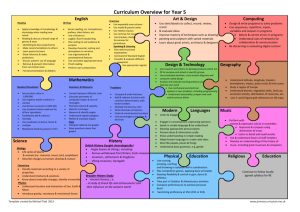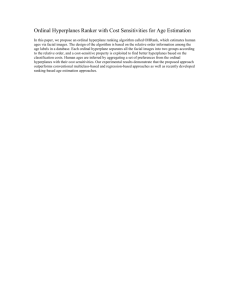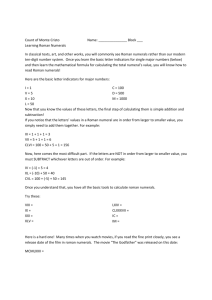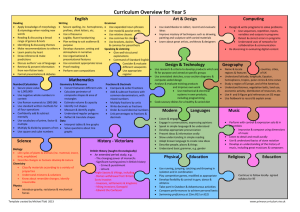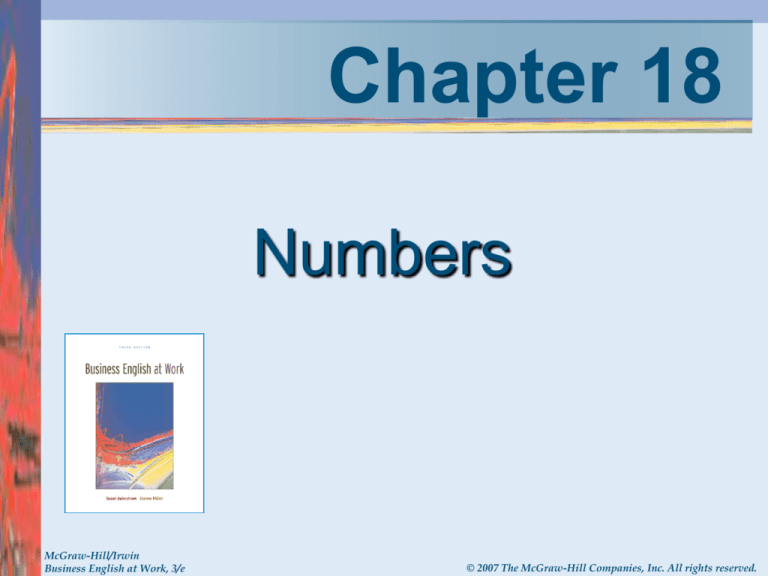
Chapter 18
Numbers
McGraw-Hill/Irwin
Business English at Work, 3/e
© 2007 The McGraw-Hill Companies, Inc. All rights reserved.
Objectives
Identify appropriate times to use words versus
figures in expressing numbers.
Differentiate between cardinal and ordinal numbers.
Use numbers with addresses, ages, and dates
correctly.
Use numbers in decimals, fractions, measurements,
identification numbers, and financial quotes
correctly.
PP 18-1a
Objectives
continued
Use numbers in amounts of money and
percentages correctly.
Use numbers correctly in political divisions,
publications, ratios, titles, inclusive sets of figures,
and sizes.
Use numbers in telephone numbers, temperatures,
time, and time periods correctly.
PP 18-1b
Numbers 1-10; Numbers Over 10
Use words to express numbers one through
ten.
I had two problems downloading the software
from the Internet.
Use figures to express numbers over ten.
The online office supply store delivers 200 orders
a day.
PP 18-2
Approximate Numbers
Express approximate numbers from one
through ten in words.
About five online booksellers are profitable.
Express approximate numbers over ten in
figures.
More than 50 dry cleaners have Web pages.
PP 18-3
Related Numbers
Adopt a consistent style for writing related
numbers in a sentence. When related
numbers, both above and below ten are used
in the same sentence, express all related
numbers in figures.
Do not express numbers ten and below in
figures if the other numbers in the sentence
are not related.
PP 18-4a
Related Numbers
continued
Examples
The Gap recently hired 5 sales associates in
Littleton, 3 in Anchorage, and 12 in San Francisco.
Out of the 20 self-appraisal evaluations
distributed, only 5 were returned by the deadline.
Even though we have over 800 employees, we
only employ 2 people in public relations.
PP 18-4b
Cardinal and Ordinal Numbers
Write cardinal numbers as follows:
one
1
two
2
twelve
12
twenty-five
25
Write ordinal numbers as follows. The ordinal
numbers are used to show the order of
succession.
first
1st
second
2nd or
2d
twelfth
12th
twenty-fifth
25th
PP 18-5
Commas in Numbers
Use commas to set off a whole number with
five or more digits in three-digit groups
beginning at the right.
13,987
243,788
7,893,283
Omit the comma in a whole number with only
four digits.
2000
7500
3250
PP 18-6a
Commas in Numbers
continued
Use the comma if a number with only four
digits is used in conjunction with numbers of
five digits or more; for example, in a column.
1,875
15,620
3,000
PP 18-6b
Abbreviations
Use figures with abbreviations.
No. 2 pencil
3 in
Bldg. 11
2/10,n/30
Fig. 23
20 m
65 mph
15 gal
PP 18-7
House and Building Numbers
Write house and building numbers in figures
except for those identified as One.
Do not use commas in house or building
numbers.
135 Alana Way
1821 ½ Lakeville
One Ward Parkway
Building 119B
11422 Old Redwood Road
PP 18-8
Street Addresses
Use words (ordinal format) to express street
names that contain the numbers 1-10.
25 Sixth Street
3902 Tenth Street
Use figures (ordinal format) to express
numbered street names above 10.
384 101th Street
3489 South 73d Avenue
PP 18-9
Highway Numbers/ZIP Codes
Use figures to identify highway numbers.
Pacific Coast Highway 1
Route 66
Interstate 10
Old County Route 13
Use figures for all ZIP Codes.
Do not use commas with ZIP Codes.
Redding, CA 96001
Buffalo, NY 14201-4732
PP 18-10
Miscellaneous Address Numbers
Use figures for suite numbers, mailstop
codes, and post office box numbers. Use
exact user designed e-mail addresses.
Suite 105, Tribune Building
P.O. Box 3879 or Post Office Box 3879
MSC 38
Lpena348@hotmail.com
PP 18-11
General Age/Precise Age
Use words to indicate general age.
My son was six when he started using the Internet.
People in their eighties typically do not trade stocks
online.
Use figures to express age when the age appears
immediately after the person’s name or when the
age is expressed in years, months, and days.
Adam Carston, 31, is our Webmaster.
The average length of employment for our staff
is 5 years 3 months.
PP 18-12
Legal Age
Use figures to express legal age.
You may receive a provisional driving permit if
you are under 18 but at least 15 years of age.
If you were born before 1938 and you meet all
other requirements, you can receive social
security benefits beginning with the first full month
that you are age 62.
PP 18-13
Emphasis on Age
Use figures to emphasize age in general
correspondence.
The bank offers a special savings account for
10- to 17-year old children.
PP 18-14
Anniversaries and Birthdays
Spell out ordinal numbers to express
anniversaries that contain one or two words. (A
hyphenated ordinal number counts as one word.)
Use ordinal numbers in figures to express
anniversaries that contain more than two words.
the company’s fifth anniversary
Julie’s twenty-fifth birthday
the city’s 125th anniversary
PP 18-15
Adjacent Numbers
Use a comma to separate adjacent numbers in a
sentence when both figures are numbers or both
are words.
By the year 2008, 75 percent of American
households will have computers.
PP 18-16
Beginning of a Sentence
Use words to express numbers that begin a
sentence.
Use hyphens with the numbers 21 through 99
expressed in words.
Reword the sentence if the beginning number
consists of more than two words A hyphenated
word counts as one word.
Seventy-three orders were the result of our Web
banner advertisements.
PP 18-17
Consecutive Numbers
Generally, use words for the first number in
consecutive numbers when one of the two numbers
is part of a compound modifier.
Four 37-cent stamps
five 10-page reports
Use figures for the first of the consecutive numbers
if the second number is shorter than the first when
written out.
300 first-time orders
67 one-page memos
PP 18-18
Months, Days, and Years
Use cardinal numbers to express dates in monthday, month-year, or month-day-year order.
Use commas to separate the year from the month
and day.
All entries must be postmarked by June 30, 2007, to be
eligible for the drawing.
Do not use commas to separate a month and year
when used without the day.
The October 2005 issue is about e-commerce.
PP 18-19
Military and Foreign
Use cardinal numbers to express dates
associated with military or foreign
correspondence.
Write dates in day, month, year sequence.
Do not separate with commas.
4 July 2007
29 December 2008
PP 18-20
Days Before Month, Days Alone
Use ordinal numbers when the day comes before the
month or stands alone and the emphasis in the
sentence is on the figure.
Use ordinal words when the purpose of the writing is
more formal. The intent of the sentence determines
the use of figures or words.
Our online site will be available by the 5th of
February.
We anticipate an answer by the 31st.
You are cordially invited to our first anniversary
celebration on the first day of March 2006.
PP 18-21
Legal Documents
Use ordinal words to express dates appearing in
legal documents.
April nineteenth
or
the nineteenth day of April
WITNESS WHEREOF I have hereunto set my hand
and seal the twenty-third day of September, in the
year two thousand six.
PP 18-22
Decades and Centuries
Use words or figures to express decades.
the 1980s
the eighties
during the years 2000-2010
the ’80s
Use words or figures to express centuries.
the 1900s
the twenty-first century
PP 18-23
Writing Decimals, Using Zeros
Use figures to express decimals.
2.478
488.3
49.3889
Place a zero before the decimal point if the
decimal appears by itself.
0.08
0.00478
0.73
PP 18-24
Aligning Figures, Financial Quotes
Align figures at the decimal point. Add a zero or
zeros at the end of a decimal to justify a column
of figures on the right.
8.7
148.9
38.48
3.90
5.000
15.400
8.379
Use figures to express financial quotes.
Our company stock was up 3/8 and closed at 67.
PP 18-25
Fractions
Use words to express fractions that stand
alone.
Use a hyphen between the numerator (top
number in a fraction) and denominator (bottom
number in a fraction).
one-half of our online orders
one-third of the questions
one-fourth of a newsletter
PP 18-26
Fractions in Measurements
Use figures to express fractions in
measurements.
Do not use an “of” phrase after fractions
written in figures.
Write out the fraction in words if an “of” phrase
must follow the fraction.
Do not use st, ds, or ths after fractions
expressed in numbers.
PP 18-27a
Fractions in Measurements
continued
Examples
1/8 ounce or
1/2 pound or
one-eighth of an ounce
one-half of a pound
PP 18-27b
Fractions and Whole Numbers
Use figures when a fraction is written with a
whole number.
Do not use a hyphen between the whole
number and the fraction.
3 ½ hours early
7 ¼ pages
PP 18-28
Identification Numbers
Use figures to identify forms or items such as form
numbers, model numbers, serial numbers, policy
numbers, and invoice numbers.
Do not use commas to separate the digits. The
abbreviation No. is not necessary with most items
identified by number if the item is preceded by a
descriptive noun.
Form 1060
Policy 3774737
Invoice 4783
Model 389-Z3
Item 478283-C
Chapter XI
PP 18-29a
Identification Numbers
continued
Follow the style of the source. Some serial
numbers are written with hyphens, spaces, or
other devices.
Patent No. 111,783
Social Security No. 378-49-2988
PP 18-29b
Indefinite Numbers
Use words to express indefinite numbers and
amounts. Indefinite numbers are not easily
counted or determined.
many hundreds of orders
several thousand requests
a few hundred responses
dozens of calls
hundreds of dollars
millions of people
PP 18-30
Large Numbers
Use a combination of figures and words to
express numbers in the millions or above. If
several large numbers appear in a sentence,
be consistent in the format.
2 billion people
1.3 million users
One company decided to send 6,000 e-mail
advertisements after estimating that at least
1,300,000 people have e-mail accounts.
PP 18-31
Measurements
Use figures (including the numbers 1 through 10) to
express measurements used in a technical sense.
These measurements include items such as yards,
inches, feet, acres, pounds, ounces, gross, dozen,
gallons, quarts, computer measurements, and miles.
Do not use a comma to separate a measurement that
consists of two parts.
15 yards (yd)
8 pounds 3 ounces 10 quarts (qt)
12 dozen (doz)
1.5 gigabytes (GB) 23 miles (mi)
PP 18-32
Dimensions
Use figures to express dimensions.
15- by 20-foot storage area
or
15- X 20-foot storage area
a room 12 X 15 feet
or
a room 12’ X 15’
a storage area 15 by 20 feet
12’ X 15’ room
PP 18-33
Metric Measurements
Use figures to express metric measurements.
Use a space to mark off groups of three digits.
a trip of 210 km (kilometers)
about 35 kg (kilograms)
a distance of 200 000 m (meters)
PP 18-34
Amounts of Money Above $1
Use figures to express amounts of money
over $1.
Do not use a decimal point or zeros after even
dollar amounts within a sentence.
$3.76
$30
$15.38
$5000
$382.90
$34,493.47
about $60,000
The online order includes $1000 plus the sales
tax of $80 for a total of $1080.
PP 18-35
Amounts of Money in Columns
Use zeros with even dollar amounts in a
column of figures in which the other amounts
contain cents.
$ 800.00
2036.89
48.78
PP 18-36
Foreign Money
Generally, place the abbreviated identification
of foreign money before the amount.
EUR500 (euro)
NZD1000 (New Zealand dollar)
PP 18-37
Large Amounts of Money
Combine figures and words to express
amounts of money of $1 million or more.
Use the dollar sign or the word dollars, but
do not use both with one figure.
Preferred
$3 million
$6 1/2 million
$7.5 million
or
or
or
Acceptable
3 million dollars
6 1/2 million dollars
7.5 million dollars
PP 18-38
Related Amounts of Money,
Amounts of Money Less Than $1
Keep related amounts of money in the same
format.
Our former building cost $2,000,000; however, we
paid $3,800,000 for our new building.
Use figures to express amounts below $1. Spell
out the word cents after the amount.
The cost of mailing the brochure was 75 cents.
The 5-cent discount did not interest many customers.
PP 18-39
Cents in a Series,
Range of Amounts of Money
Do not use the dollar sign with an amount less than
$1 unless it appears in a series or in a table in which
the other figures require dollar signs.
The costs of mailing the packets were $4.38, $ .55,
$14, and $7.39.
Repeat the dollar sign or cent sign with each amount
when a range of prices is expressed.
Do not repeat the word dollars or cents with each
amount.
in the $15,000 to $20,000 range
a decrease from 15 to 10 cents
PP 18-40
Amounts of Money in
Legal Documents
Use words to express amounts of money in legal or
formal documents.
Write the amount in figures, and place it in
parentheses after the written expression.
Use the word and before the cents in written
expressions of money.
Two Hundred Thousand Dollars ($200,000)
One Thousand Three Hundred Thirty-five and 37/100
Dollars ($1,335.37).
PP 18-41
Exact and Approximate Percentages,
Series of Percentages
Use figures to express exact or approximate
percentages.
Write the word percent after the number.
0.8 percent
15 percent
5 ½ percent
over 75 percent
nearly 55 percent
7.2 percent
Write the word percent only at the end of the last
number in a sentence with several percentages listed.
We receive discounts of 10, 20, and 30 percent from
Wolfard & Company.
PP 18-42
Political Divisions, Publications
Use words to identify political subdivisions such as
congressional districts or precincts.
Tenth District representative
First Precinct election returns
Use figures to express pages, paragraphs, chapters,
lines, and verses in publications.
Do not capitalize the words page, line, verse, or
paragraph before the numbers.
page 25, line 3
paragraphs 34-43
PP 18-43
Ratios
Use figures to express ratios.
2-to-1 ratio
or
a 2:1 ratio
PP 18-44
Roman Numerals in
Outlines and Reports
Use roman numerals to subdivide items on
outlines or reports.
Align roman numerals at the right in an outline or
list.
Place a period after the numeral.
I. WORKING WITH EXCEL GRAPHICS
II. WORKING WITH LISTS AND DATABASES
III. ANALYZING INFORMATION
PP 18-45
Roman Numerals as Literary
Divisions, as Lowercase
Use roman numerals to indicate the major parts of
complete literary works such as volumes or chapters.
Volume XIV
Chapter V
Use lowercase roman numerals to indicate page
numbers in prefaces or in other materials that
precede text materials.
Please check page iii at the beginning of our catalog for
more information about our shipping policies.
PP 18-46
Seniority Titles
Use roman numerals or arabic numerals for
seniority titles.
Do not set aside seniority titles with commas.
Daniel Russell II
Mark Robbins III
or
or
Daniel Russell 2d
Mark Robbins 3d
PP 18-47
Inclusive Figures
Do not shorten the second number in an
inclusive set of figures unless page numbers or
dates are used frequently in a document.
pages 146-50 (frequent use)
or
pages 146-150 (general use)
Do not shorten inclusive numbers under 100.
pages 47-57
PP 18-48a
Inclusive Figures
continued
Do not shorten the second number when the
second number begins with a digit that is different
from the first number.
pages 123-328
Do not use a shortened form for the second
number in any situation in which the first number
ends in two or more zeros.
pages 200-205
PP 18-48b
Size, Symbols
Use figures to express size.
Do not capitalize the word size when it
appears before the number.
My wrist requires a size 6 wrist support.
Use figures with symbols.
6 @ $25 (6 items at $25 each)
#2 pencil (Number 2)
PP 18-49
Domestic Telephone Numbers
Use figures for most telephone numbers. If a
company uses combinations of letters and
numbers or all words, follow the company’s exact
format.
Use diagonals, parentheses, periods, or hyphens
to separate the area code from the rest of the
number.
515/555.3456
(515) 555-3416
515.555.3416
515-555-3456
PP 18-50
International Telephone Numbers
Use figures for international telephone
numbers.
Separate the international access codes,
country codes, city codes, and telephone
numbers with hyphens.
011-32-3-34-859-238
PP 18-51
Extensions, Temperature
Use figures to identify an extension.
Spell out Extension or abbreviate it (Ext.).
510-555-4893, Extension 3964
510-555-4893, Ext. 3964
Use figures to express temperatures.
Do not space between the number and the
degree symbol or between the symbol and C
(Celsius) or F (Fahrenheit).
55 degrees
55 degrees Fahrenheit
55°F
100°C
PP 18-52
Time With a.m. and p.m
Use figures with a.m. and p.m.
Do not space within a.m. or within p.m.
Do not use the word o’clock with a.m. and p.m.
Our office closes at 5 p.m.
Omit the colon and zeros with times that do not
involve minutes (even when other expressions of
time in the sentence include minutes).
Our office opens at 7:30 a.m. and closes at 5 p.m.
PP 18-53
Time with the Word O’clock
and in Time Phrases
Use figures with o’clock to emphasize time.
Use words with o’clock to set a formal tone; for
example, in social invitations.
1 o’clock
or
one o’clock
Do not use the expressions in the morning, in the
afternoon, in the evening, or at night with a.m. or p.m.
Our office opens at 8 o’clock in the morning.
PP 18-54
Time With Noon and Midnight
Express the terms noon and midnight in
words. If other times in a sentence are written
in figures, use 12 noon or 12 midnight.
We are planning an informal luncheon at noon.
We are planning an informal luncheon from 12
noon to 1:15 p.m.
PP 18-55
General Time Periods/
Business-Related Time Periods
Use words to express general time periods such as
years, months, weeks, and days except when the
time period requires more than two words.
During the past two years, we have increased our use of
temporary employees.
Our business is open 365 days a year.
Use numbers to indicate a time period associated
with payroll periods, discounts, and interest
payments.
We have a 3-year lease on this copy machine.
PP 18-56


